|
Report from
Europe
UK import tropical wood import tonnage falls 24% in
the first half of 2023
The import value of tropical wood and wood furniture into
the UK in the first six months of this year was US$486
million, 43% less than the same period last year. In
quantity terms, the UK imported 203,600 tonnes of
tropical wood and wood furniture in the January to June
period, 24% less than the same period last year.
The sharp decline was expected as trade in the opening
months of last year was at the highest level (in dollar
terms) since before the 2008 financial crises and had
already slowed markedly since summer 2022.
The UK imported 105,700 tonnes of tropical wood and
wood furniture with a value of US$251 million in Q2
2023, respectively 20% and 41% less than the same period
last year.
However, import tonnage and value during the second
quarter this year were up 8% and 6% respectively
compared to the first quarter.
The quarterly increase in imports was all due to a rise in
HS44 wood products. UK imports of tropical wood
furniture products remained slow in the second quarter of
this year (Charts 1a and 1b).
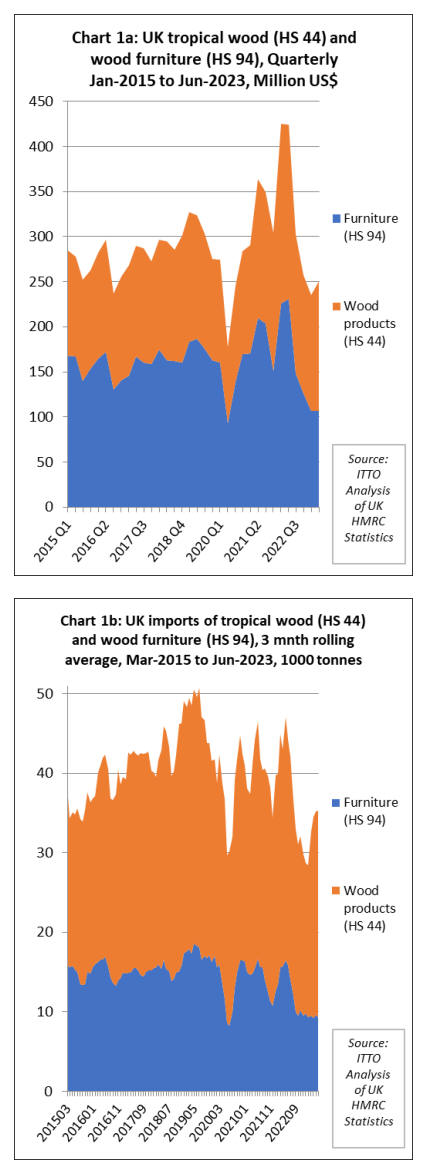
60 percent risk of recession in the UK this year
The latest report from the UK National Institute of
Economic and Social Research (NIESR) published on 9
August highlights that the British economy is growing
only very slowly, and that this trend is set to continue.
At the end of the first quarter this year, UK GDP was still
0.5 per cent below the level of GDP before the pandemic
and NIESR forecast that it will not pass this level until the
third quarter of 2024.
According to the NIESR, “Despite continuing to expect
the United Kingdom to steer clear of a recession in 2023,
GDP is projected to grow barely by 0.4 per cent this year
and by 0.3 per cent in 2024, with the outlook remaining
highly uncertain. There are, in fact, even chances that
GDP growth will contract by the end of 2023 and a
roughly 60 per cent risk of a recession at the end of 2024”.
The main reasons for this lost wealth and hit to prosperity,
according to the NIESR, are the pandemic, Brexit, and
Russia’s war against Ukraine. The monetary tightening
necessary to bring inflation down has also played a role.
These commonly cited reasons are often bunched together,
and the reality is that the overlap of these events makes it
very difficult to pinpoint specific blame.
NIESR's outlook is more pessimistic than the Bank of
England's forecasts published a week earlier which came
as the Bank raised the base rate for the 14th time in a row.
The Bank suggested a recession was unlikely in the
coming years but also implied that the economy will
effectively flatline all the way through to 2026.
Expectations of a recession in the UK seem to be rising
amongst other forecasters. For example, Capital
Economics is predicting a recession before the end of the
year. The IMF’s most recent updates predict the UK will
just about avoid recession, but only on the condition that
serious public policy reforms are implemented soon,
notably more tax incentives for businesses.
For the hardwood sector, some crumbs of comfort may be
derived from sector specific surveys. The latest S&P
Global/CIPS UK Construction Purchasing Managers’
Index for July shows an overall return to growth. The
index stood at 51.7 in July, up from the previous month’s
48.9 score, and exceeding the 50 mark which indicates
positive growth.
Robust increases in commercial building (indexed at 54.4)
and civil engineering (53.9) did just enough to offset a
continuing steep fall in house building (43.0). Significant
growth in refurbishment projects during the month is
encouraging for hardwoods as these projects tend to use
more hardwoods than the new build sector.
Similarly, the latest State of Trade Survey by the UK
Construction Products Association (CPA) covering the
second quarter of 2023 showed a split in performance in
the construction products manufacturing industry. In this
case the divide was between manufacturers of “heavy
side” materials, which recorded a fourth consecutive
quarterly downturn, and of “light side” materials, which
added to a run of quarterly growth that began in the third
quarter of 2020.
“Heavy side” materials are typically installed early in the
construction process and include structural timber
products alongside aggregates, cement, ready-mix
concrete, and structural steel.
“Light side” products are installed later in the construction
process and include internal fittings and services such as
doors, windows, and kitchen furniture alongside heating
and ventilation systems, plumbing, electrical and lighting
and thermal insulation sector.
It is encouraging that applications for hardwoods are more
prevalent on the expanding “light side” than the declining
“heavy side”. According to the CPA, “strong activity in
commercial refurbishment, energy efficiency
improvements and fit-out work has driven a three-year run
of growth for light side product manufacturers, which
contrasts with reticence for new project starts (particularly
for private housing, and commercial and factory new
builds) that continues to hold back heavy side sales”.
UK import value of tropical wood furniture down more
than 50%
The UK imported US$213 million of tropical wood
furniture products in the first six months of 2023, which is
53% less than the same period last year. In quantity terms,
wood furniture imports were 56,100 tonnes during the six-
month period, 40% less than the same period last year.
In the first six months of 2023 compared to last year, UK
import value of wood furniture from Vietnam was down
50% to US$115 million, Malaysia was down 46% to
US$43 million, India was down 59% to US$22 million,
Indonesia was down 55% to US$20 million, Thailand was
down 46% to US$6 million, and Singapore was down 87%
to US$4 million. (Chart 2).
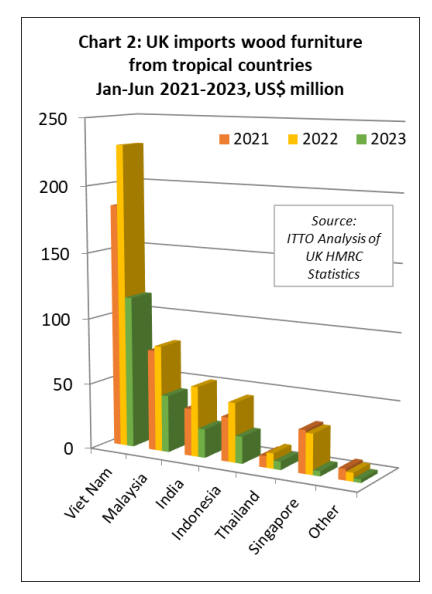
Across the board decline in UK import value of all
tropical wood products
Total UK import value of all tropical wood products in
Chapter 44 of the Harmonised System (HS) of product
codes was US$273 million between January and June this
year, 31% less than the same period in 2022.
In quantity terms imports decreased 15% to 147,400
tonnes during the period. Compared to the first six months
of 2022, UK import value of tropical joinery products
decreased 37% to US$104 million, import value of
tropical plywood decreased 36% to US$63 million, import
value of tropical sawnwood decreased 11% to US$59
million, and import value of tropical mouldings/decking
decreased 31% to US$13 million (Chart 3).
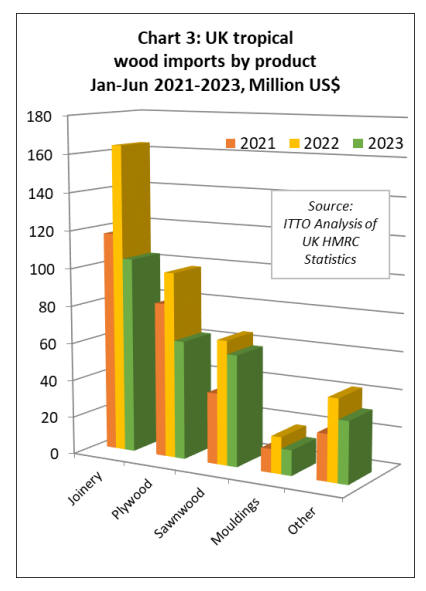
UK import value of joinery products from Indonesia
(mainly doors) was US$52 million in the first six months
of 2023, down 52% compared to the same period last year.
UK import value of joinery products from Malaysia
(mainly laminated products for kitchen and window
applications) fell 39% to US$13 million during the same
period. UK import value of Chinese tropical joinery
products, nearly all comprising doors, was US$16 million
in the January to June period, 28% less than the same
period last year (Chart 4).
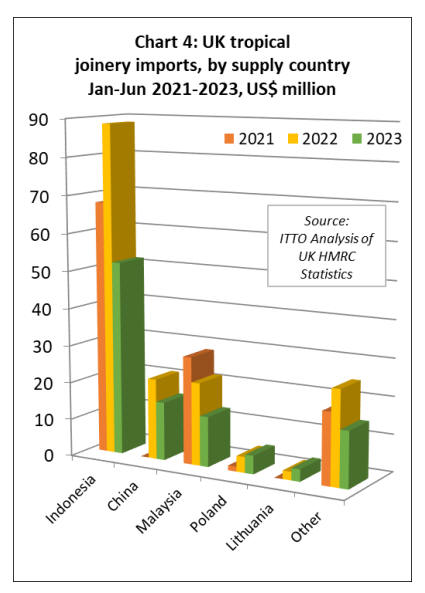
UK direct imports of tropical hardwood plywood offset
by rise from China
In the first six months of 2023, the UK imported 108,100
m3 of tropical hardwood plywood, 10% less than the same
period last year. A significant decline in direct imports of
tropical hardwood plywood from tropical countries partly
offset by a rise in imports from China (Chart 5).

The UK imported 47,500 m3 of tropical hardwood
plywood from China in the first six months of 2023, 48%
more than the same period last year. Last year, UK
imports of Chinese products faced with tropical
hardwoods fell sharply in favour of Chinese products
faced with temperate hardwoods. This trend has been
reversed in 2023 with China again shipping a larger
proportion of tropical hardwood faced plywood to the UK.
UK imports of Indonesian plywood in the first six months
this year were, at 26,900 m3, 24% less than the same
period last year. The UK imported 21,300 m3 of plywood
from Malaysia in the first six months of 2023, 33% less
than the same period last year. UK plywood imports from
Thailand were down 70% to 2,100 m3 in the first six
months this year.
However, in the same period there was a large percentage
increase from a very small base in tropical hardwood
plywood imports from Brazil (+148% to 3,100 m3).
Imports from Paraguay also increased 13% to 1,600 m3.
Meanwhile, the combined effects of Brexit, supply
shortages and rising energy and other material costs on the
European continent continue to impact on UK imports of
tropical hardwood plywood from EU countries which were
just 4,300 m3 in the first six months of this year, 35% less
than the same period last year.
Rising UK imports of tropical sawnwood from the EU
this year
UK imports of tropical sawnwood were 54,000 m3 in the
first six months of this year, 2% less than the same period
in 2022. Although UK imports of this commodity appear
to have held up reasonably well compared to other tropical
products this year, a larger share has been sourced
indirectly from the EU and not direct from the tropics
(Chart 6).

Furthermore, a large increase in UK imports of tropical
hardwood sawnwood (HS 4407) from Brazil this year is
also offset by a significant decline in imports of Brazilian
tropical hardwood decking/mouldings (HS4409).
Therefore, it may be that reported trends for both
commodities are distorted by changes in the way products
from Brazil are categorized respectively as “sawnwood”
and “mouldings”.
UK imports of tropical sawnwood from Cameroon were
19,300 m3 in the first six months of 2023, 6% less than the
relatively high level in the same period in 2022. UK
tropical sawnwood imports from Malaysia, which revived
to some extent last year after many years of decline, fell
by 57% in the first six months of this year to 4,700 m3.
UK imports of tropical sawnwood from Brazil were
reported as 4,800 m3 in the first six months of this year, a
gain of 98% compared to the same period in 2022. UK
tropical sawnwood imports also increased in the first six
months this year from Republic of Congo (+29% to 1,600
m3), and Ghana (+78% to 1,300 m3). However imports
from Guyana fell 12% to 1,700 m3.
Indirect UK imports of tropical sawnwood via the EU
recovered ground despite the Brexit disruption, increasing
8% to 13,800 m3 in the first six months of 2023. To some
extent, UK’s continuing dependence on indirect imports of
tropical sawnwood from the EU is due to a shortage of
kiln drying space in African supply countries combined
with lack of any hardwood kiln dying capacity in the UK.
UK imports of tropical hardwood mouldings/decking fell
31% in the first six months of 2023 to 4,500 tonnes. This
commodity group benefited in the UK market during 2022
from shortages of non-tropical products, particularly since
the start of the war in Ukraine and sanctions on Russian
decking products that directly compete with tropical
decking.
However, with high stocks built up in the UK last year and
much reduced consumption, imports of tropical
mouldings/decking have fallen away again this year.
Imports of 1,500 tonnes from Indonesia were 43% less
than the same period in 2022. Imports from Malaysia
totalling 1,300 tonnes were down 20% compared to the
same period last year.
Imports of this commodity group from Brazil were
recorded at less than 200 tonnes in the first six months of
this year, 86% less than the same period last year. In
contrast, imports increased 123% from the Netherlands to
891 tonnes, while imports from Vietnam increased 3-fold
to 350 tonnes from a very small base (Chart 7).
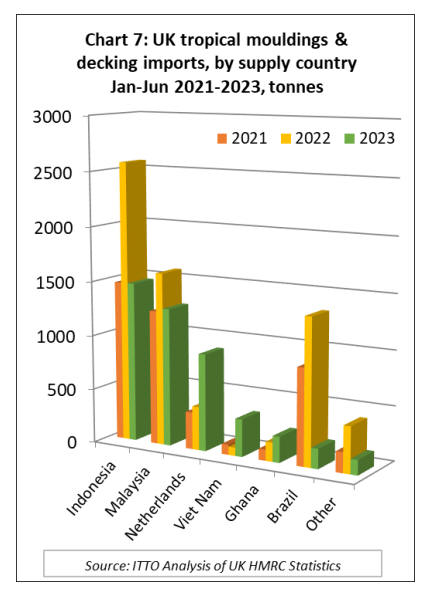
ETTF issues EUDR guidance for timber exporters
The European Timber Trade Federation (ETTF) has issued
the following information on the EU Deforestation
Regulation (EUDR) for suppliers exporting timber and
timber products to the EU:
The EU Deforestation Regulation (EUDR) entered into
force on 29.06.2023. From 30.12.2024, the EUDR will
replace the EU Timber Regulation (EUTR). It obliges all
importers of timber or timber products in the EU to apply
a due diligence system prior to importing.
Importers must collect information and documentation to
prove that their wood and wood products have been
legally harvested and are deforestation-free, prior to
placing these products on the EU market. Deforestation-
free means that the wood comes from plots of land where
no deforestation or forest degradation as defined in the
Regulation has occurred since 31.12.2020.
The EUDR covers a wide range of timber products,
including sawn timber, wood-based materials, paper and
furniture.
The text of the regulation is available here (https://eur-lex.europa.eu/legal-content/EN/TXT/?uri=CELEX%3A32023R1115&qid=1687867231461).
The scope of the EUDR, including all products covered,
can be found in Annex I at the end of the Regulation.
Products covered by CITES or FLEGT licenses are also
affected by the EUDR.
In future, you (exporter) will need to provide EU
importers (i.e. your customers) with the following
information and documentation to enable them to comply
with the requirements of the EUDR:
1. Tree species (scientific name)
2. Country of harvest
3. Geo-coordinates of all plots of land where the
wood was harvested
4. Date or time range of harvest
5. Evidence that the wood was legally harvested
6. Evidence that the wood is deforestation-free
If the required information and evidence is missing, the
goods will not be released for import into the EU by the
Customs authorities. There is a risk of storage charges at
EU borders until the necessary information is provided or
the goods have to be returned. Importers may also face
legal consequences.
The EUDR applies to all wood and wood products
harvested from 29.06.2023 and placed on the EU market
from 30.12.2024. It is therefore important that you start
gathering the necessary information now. Without this
information you will no longer be able to export wood
products to the EU from 30.12.2024.
A special case applies to wood products harvested from
29.06.2023 and delivered to the EU before 30.12.2024.
For these products, importers must apply the EUTR and
check that the wood was legally harvested. However, if
these products (or wood products made from them) are
traded in or exported from the EU after 30.12.2024,
importers and their customers will need the information
and documentation mentioned above.
The ETTF urges “all exporters to inform their timber
suppliers of this new regulation and forward this
information to them. This is the only way your suppliers
can provide you with the necessary information in time”.
The ETTF provides the following additional notes on the
information and documentation that importers in the EU
will need in the future to comply with the requirements of
the EUDR:
1. Tree species (scientific name)
The scientific names of all tree species (possibly)
contained in the product are required. The genus
(e.g. Pinus spp. or Eucalyptus spp.) is not
sufficient! Both genus and species must be
indicated (e.g. Pinus radiata or Eucalyptus
globulus).
Please note that the European authorities can
verify information on tree species by means of
laboratory tests (microscopic analysis, genetic
analysis).
2. Country of harvest
The name of the country or countries where the
wood was harvested is required. If deforestation
or legality risks vary within a country, the region
must also be indicated.
Please note that the European authorities can
verify information on the country of harvest by
means of laboratory tests (genetic analysis,
isotope analysis).
3. Geo-coordinates of all plots of land where the wood was
harvested.
Exact geo-coordinates of all plots of land where
the wood contained in the product was (possibly)
harvested are required. For plots of 4 hectares or
less, one point is sufficient; for plots of more than
4 hectares, a sufficient number of points is
required to describe the perimeter of the plot.
Coordinates consist of a latitude and a longitude
value, with a minimum of at least six decimal
places.
Please note that importers are required to enter
the quantity of imported products as well as the
coordinates for each individual import into an EU
online portal. Through this portal, the EU can
detect unrealistic information, for example if
suppliers send the same coordinates to multiple
importers, even though the wood comes from
other areas.
4. Date or time range of harvest Information is required on
the date or time range of harvest.
Please note that the European authorities can use
satellite imagery to determine whether harvesting
took place on the plot land during the specified
period.
5. Evidence that the wood was legally harvested
The EUDR requires that the timber has been
harvested in accordance with the relevant
legislation of the country of production. The
following legislation is mentioned in the EUDR:
• Land use rights
• Environmental protection
• Forest-related rules, including forest
management and biodiversity
conservation, where directly related to
wood harvesting
• Third parties’ rights
• Labour rights
• Human rights protected under
international law
• The principle of free, prior and informed
consent (FPIC), including as set out in
the UN Declaration on the Rights of
Indigenous Peoples
• Tax, anti-corruption, trade and customs
regulations.
The evidence required in each case will depend
on the applicable legislation in the country of
harvest and the local legality risks. Depending on
the situation, some aspects may not be relevant.
If indigenous peoples are present in or around the
logging area, it will be necessary to demonstrate
that their rights have not been violated.
If there are legal requirements for logging permits
in the country of harvest, these permits must be
provided. The same applies to official transport
documentation.
If no permit is required for logging on private
land, other evidence of legality must be provided.
In addition, internationally recognised
certification schemes can help to demonstrate
legality.
Proof of the supply chain (delivery notes or
invoices) is also required to establish the link
between the geo-coordinates provided, the proof
of legality and the exported timber product. It is
important to ensure that the documentation
provided matches the timber exported and is
plausible in terms of dates and quantities.
Additional risk mitigation measures are required
for timber from countries with high levels of
illegal logging or corruption.
Timber imported into the EU with a valid FLEGT
licence is considered to have been legally
harvested under the EUDR and hence only fulfils
a part of the requirements. FLEGT-timber is no
longer a “green lane” as it used to be in EUTR.
6. Evidence that the wood is deforestation-free
Importers must demonstrate that their imported
products have not contributed to deforestation or
forest degradation. The importer can use e.g.
satellite images for this purpose. If there is other
evidence that the product is deforestation-free,
this should also be provided to the importer.
|